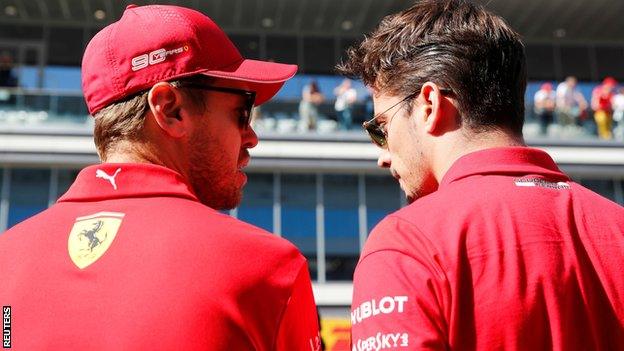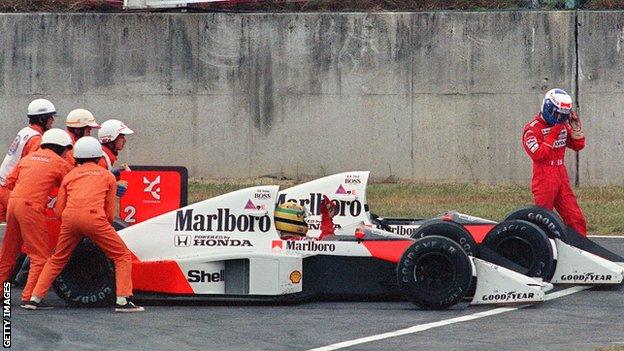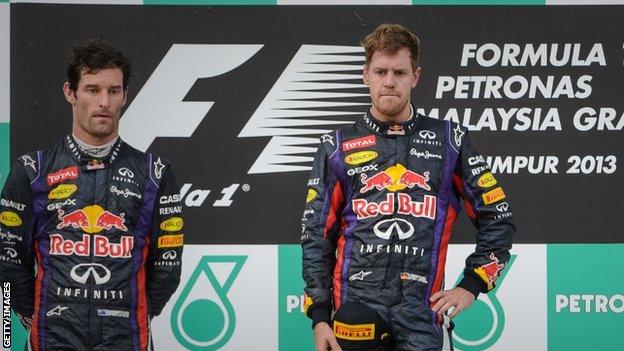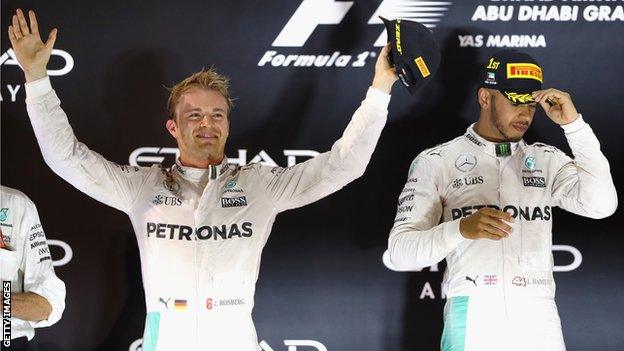F1: Where does Sebastian Vettel and Charles Leclerc's team orders issue rank?
- Published

Sebastian Vettel was resistant to move over for his team-mate in the Russian Grand Prix on Sunday - reneging on a pre-race agreement to let Charles Leclerc back past him to win.
Was Vettel's team order resistance a classic case of F1 drivers trying to establish who is the number one driver?
He's done it before. But he wasn't the first...
Power failure #1: Senna v Prost

Ayrton Senna and Alain Prost's McLaren rivalry was heightened at a memorable race at Suzuka, Japan in 1989. Prost was on pole, and Senna had to overtake to win the F1 title instead at Prost's expense. They went wheel-to-wheel knocking both of them off the track into the run-off area.
The race was over for Prost, but Senna encouraged the marshals to push him so he could weave through the run-off area back to the circuit.
The Brazilian took the chequered flag, but was later disqualified, and Prost went on to win the championship.
What happened next? Prost left McLaren, saying he couldn't work with Senna, and went to Ferrari for 1990. A year later the pair crashed out again at the same race, with Senna this time taking the title.
Power failure #2: Hamilton v Alonso

It was Lewis Hamilton's rookie year in Formula 1 where he was promoted from McLaren's driver programme to race alongside defending world champion Fernando Alonso in 2007.
After plenty of build-up, the power struggle came to a head in qualifying at the Hungarian Grand Prix.
Both cars pitted, where the team had estimated enough time for both drivers to come in and go out for a flying lap. But Alonso held Hamilton up in the pit box for an extra 10 seconds which meant Hamilton had run out of time for a flying lap, and Alonso improved to take pole position.
After a lengthy investigation Alonso was given a five-place grid penalty for "impeding another driver" and Lewis Hamilton went on to win the race.
What happened next? Alonso angrily wriggled his way out of his McLaren contract after just one year to rejoin Renault. Hamilton? Well, he has five world titles, so...
Power failure #3: Vettel v Webber

Sebastian Vettel has some previous in disobeying team orders.
At the 2013 Malaysian Grand Prix, he started on pole but was then over-taken by team-mate Mark Webber.
Red Bull gave the "multi 21" message for Vettel to hold his position in second to let Webber win, but Vettel ignored the call, attacked and then overtook Webber late on to win the race.
In a frosty post-race meeting of the two drivers, Webber glared at his team-mate saying "multi 21, Seb, multi 21". On the podium in an interview, Webber then said: "Seb made his own decisions and will have protection as usual, that's the way it goes."
What happened next? Vettel won the 2013 title (his fourth in a row), and Webber retired.
Power failure #4: Hamilton v Rosberg

These two had been at each other's throats for two seasons, with Hamilton winning the 2014 and 2015 F1 titles over Mercedes team-mate Nico Rosberg.
But in 2016 there was an epic battle the pair went for the title. It all came to a head in the final race of the season at Abu Dhabi.
Hamilton was leading the race but needed Rosberg to finish outside the top three to prevent the German winning the title.
Despite repeated attempts from the pitwall to get him to speed up, Hamilton backed up the field, raising the chance of Rosberg being overtaken. But it did not work as Rosberg came second, behind Lewis Hamilton to win the world title.
What happened next? Rosberg retired, claiming he was unable to maintain the level required to beat Hamilton again.